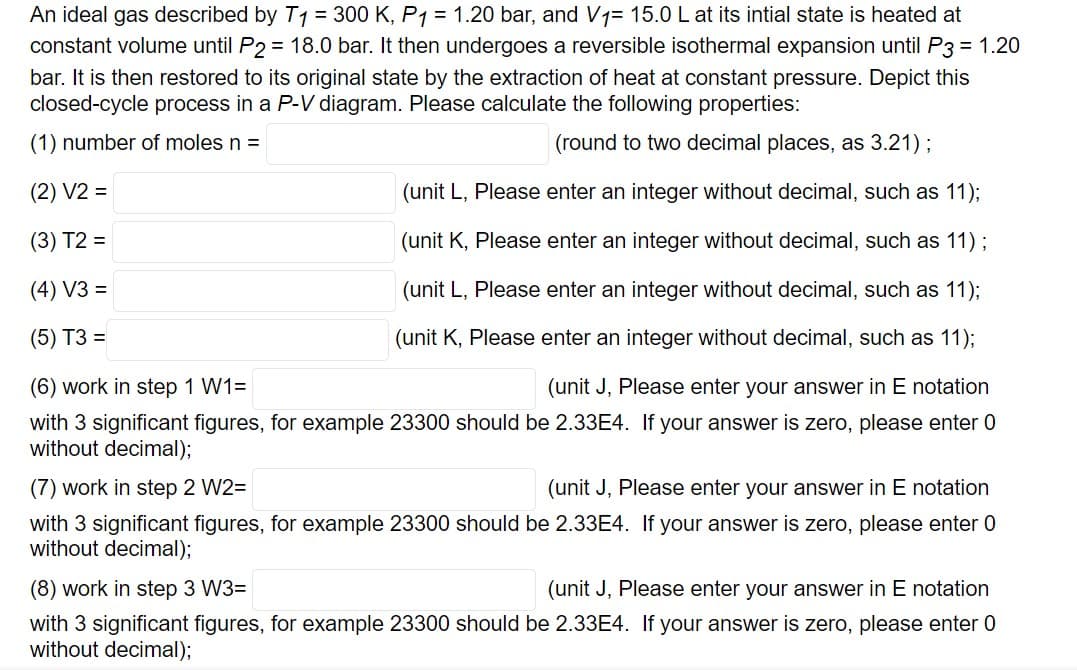An ideal gas described by T1 = 300 K, P1 = 1.20 bar, and V₁= 15.0 L at its intial state is heated at constant volume until P2 = 18.0 bar. It then undergoes a reversible isothermal expansion until P3 = 1.20 bar. It is then restored to its original state by the extraction of heat at constant pressure. Depict this closed-cycle process in a P-V diagram. Please calculate the following properties: (1) number of moles n = (round to two decimal places, as 3.21); (2) V2 = (3) T2 = (4) V3 = (unit L, Please enter an integer without decimal, such as 11); (unit K, Please enter an integer without decimal, such as 11); (unit L, Please enter an integer without decimal, such as 11); (unit K, Please enter an integer without decimal, such as 11); (unit J, Please enter your answer in E notation with 3 significant figures, for example 23300 should be 2.33E4. If your answer is zero, please enter 0 without decimal); (5) T3 = (6) work in step 1 W1= (7) work in step 2 W2= (unit J, Please enter your answer in E notation with 3 significant figures, for example 23300 should be 2.33E4. If your answer is zero, please enter 0 without decimal); (8) work in step 3 W3= (unit J, Please enter your answer in E notation with 3 significant figures, for example 23300 should be 2.33E4. If your answer is zero, please enter 0 without decimal);
An ideal gas described by T1 = 300 K, P1 = 1.20 bar, and V₁= 15.0 L at its intial state is heated at constant volume until P2 = 18.0 bar. It then undergoes a reversible isothermal expansion until P3 = 1.20 bar. It is then restored to its original state by the extraction of heat at constant pressure. Depict this closed-cycle process in a P-V diagram. Please calculate the following properties: (1) number of moles n = (round to two decimal places, as 3.21); (2) V2 = (3) T2 = (4) V3 = (unit L, Please enter an integer without decimal, such as 11); (unit K, Please enter an integer without decimal, such as 11); (unit L, Please enter an integer without decimal, such as 11); (unit K, Please enter an integer without decimal, such as 11); (unit J, Please enter your answer in E notation with 3 significant figures, for example 23300 should be 2.33E4. If your answer is zero, please enter 0 without decimal); (5) T3 = (6) work in step 1 W1= (7) work in step 2 W2= (unit J, Please enter your answer in E notation with 3 significant figures, for example 23300 should be 2.33E4. If your answer is zero, please enter 0 without decimal); (8) work in step 3 W3= (unit J, Please enter your answer in E notation with 3 significant figures, for example 23300 should be 2.33E4. If your answer is zero, please enter 0 without decimal);
Elements Of Electromagnetics
7th Edition
ISBN:9780190698614
Author:Sadiku, Matthew N. O.
Publisher:Sadiku, Matthew N. O.
ChapterMA: Math Assessment
Section: Chapter Questions
Problem 1.1MA
Related questions
Question
if possible please answer all questions

Transcribed Image Text:An ideal gas described by T1 = 300 K, P1 = 1.20 bar, and V₁= 15.0 L at its intial state is heated at
constant volume until P2 = 18.0 bar. It then undergoes a reversible isothermal expansion until P3 = 1.20
bar. It is then restored to its original state by the extraction of heat at constant pressure. Depict this
closed-cycle process in a P-V diagram. Please calculate the following properties:
(1) number of moles n =
(round to two decimal places, as 3.21);
(2) V2 =
(3) T2 =
(4) V3 =
(unit L, Please enter an integer without decimal, such as 11);
(unit K, Please enter an integer without decimal, such as 11);
(unit L, Please enter an integer without decimal, such as 11);
(unit K, Please enter an integer without decimal, such as 11);
(unit J, Please enter your answer in E notation
(5) T3 =
(6) work in step 1 W1=
with 3 significant figures, for example 23300 should be 2.33E4. If your answer is zero, please enter 0
without decimal);
(7) work in step 2 W2=
(unit J, Please enter your answer in E notation
with 3 significant figures, for example 23300 should be 2.33E4. If your answer is zero, please enter 0
without decimal);
(8) work in step 3 W3=
(unit J, Please enter your answer in E notation
with 3 significant figures, for example 23300 should be 2.33E4. If your answer is zero, please enter 0
without decimal);
Expert Solution
This question has been solved!
Explore an expertly crafted, step-by-step solution for a thorough understanding of key concepts.
Step by step
Solved in 4 steps with 1 images

Knowledge Booster
Learn more about
Need a deep-dive on the concept behind this application? Look no further. Learn more about this topic, mechanical-engineering and related others by exploring similar questions and additional content below.Recommended textbooks for you

Elements Of Electromagnetics
Mechanical Engineering
ISBN:
9780190698614
Author:
Sadiku, Matthew N. O.
Publisher:
Oxford University Press

Mechanics of Materials (10th Edition)
Mechanical Engineering
ISBN:
9780134319650
Author:
Russell C. Hibbeler
Publisher:
PEARSON

Thermodynamics: An Engineering Approach
Mechanical Engineering
ISBN:
9781259822674
Author:
Yunus A. Cengel Dr., Michael A. Boles
Publisher:
McGraw-Hill Education

Elements Of Electromagnetics
Mechanical Engineering
ISBN:
9780190698614
Author:
Sadiku, Matthew N. O.
Publisher:
Oxford University Press

Mechanics of Materials (10th Edition)
Mechanical Engineering
ISBN:
9780134319650
Author:
Russell C. Hibbeler
Publisher:
PEARSON

Thermodynamics: An Engineering Approach
Mechanical Engineering
ISBN:
9781259822674
Author:
Yunus A. Cengel Dr., Michael A. Boles
Publisher:
McGraw-Hill Education

Control Systems Engineering
Mechanical Engineering
ISBN:
9781118170519
Author:
Norman S. Nise
Publisher:
WILEY

Mechanics of Materials (MindTap Course List)
Mechanical Engineering
ISBN:
9781337093347
Author:
Barry J. Goodno, James M. Gere
Publisher:
Cengage Learning

Engineering Mechanics: Statics
Mechanical Engineering
ISBN:
9781118807330
Author:
James L. Meriam, L. G. Kraige, J. N. Bolton
Publisher:
WILEY